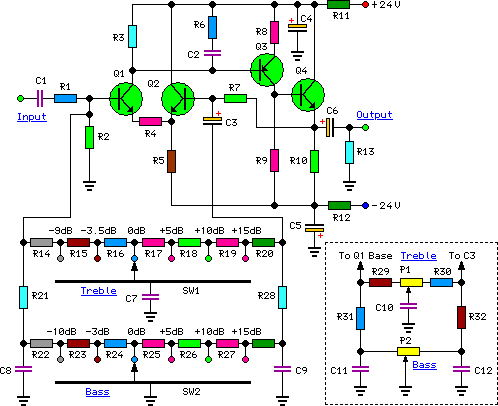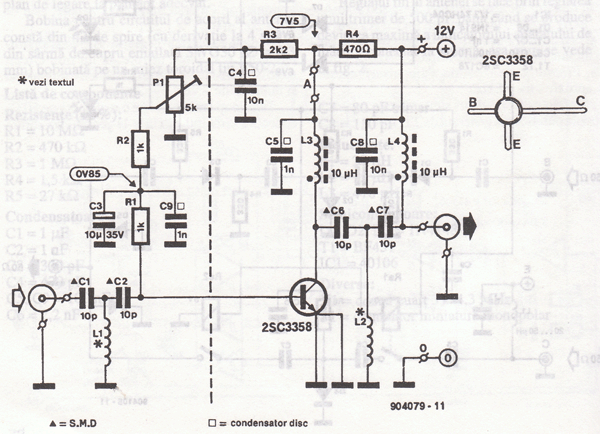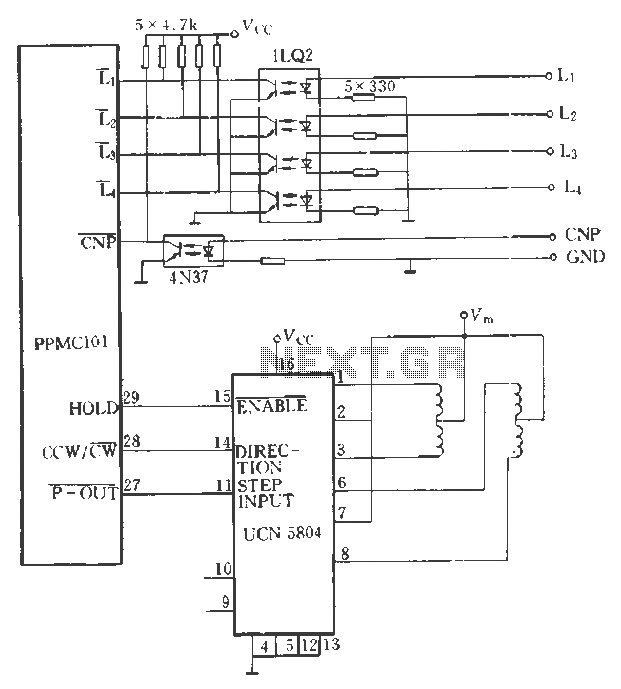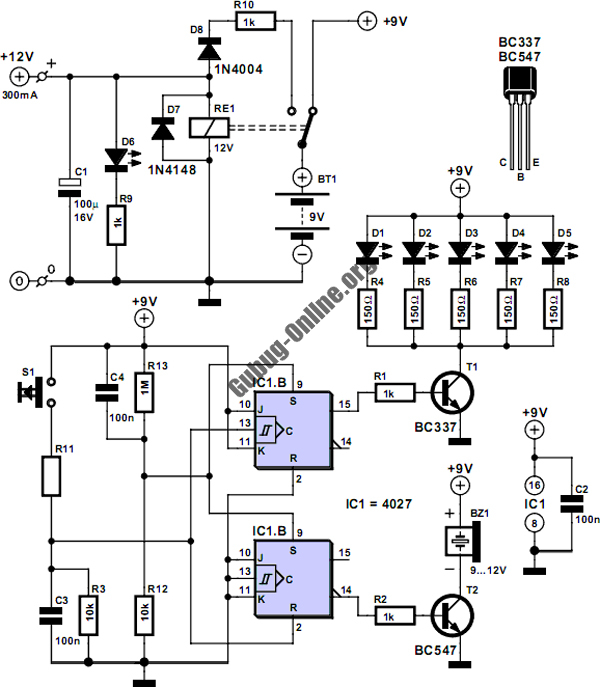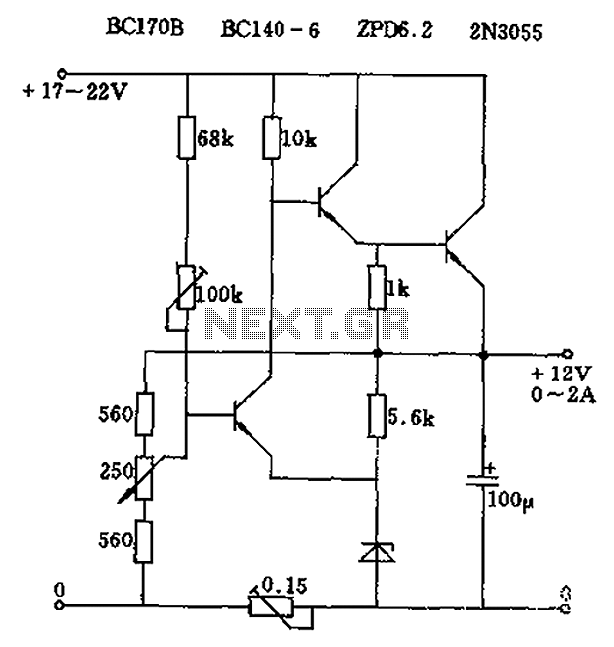
Speaker to microphone converter circuit
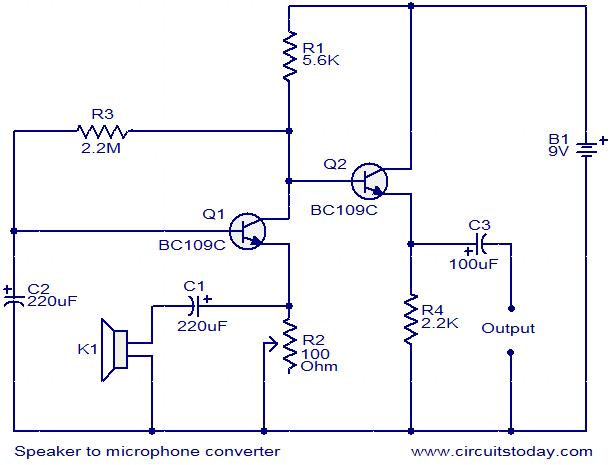
This circuit provides a straightforward method for converting a loudspeaker into a microphone. When sound waves impact the diaphragm of the speaker, fluctuations occur in the coil, generating a small induced voltage that is typically low in magnitude and not useful. In this circuit, the low voltage is amplified using transistors to yield a more usable output. The transistor Q1 is configured in common base mode to achieve the necessary voltage gain. Transistor Q2 is set up as an emitter follower to deliver sufficient current gain. While the voice quality produced by this circuit may not match that of a conventional microphone, it can still provide reasonably acceptable quality. To assemble the circuit, set the preset resistor R2 to approximately 10 Ohms, connect the battery, and then adjust R2 to achieve optimal sound quality.
This circuit operates on the principle of electromagnetic induction, where sound waves cause mechanical vibrations in the loudspeaker's diaphragm. These vibrations lead to fluctuations in the magnetic field around the coil, resulting in an induced voltage proportional to the sound pressure level. The low-level signal generated is typically insufficient for direct audio applications, necessitating amplification.
Transistor Q1, configured in common base mode, serves as the primary voltage amplifier. In this configuration, the input signal is applied to the emitter while the output is taken from the collector. This arrangement provides a high input impedance and low output impedance, allowing for effective voltage gain. The gain factor can be adjusted by varying the biasing conditions, which can be fine-tuned using the preset resistor R2.
Transistor Q2, operating as an emitter follower, is crucial for providing current gain without significant voltage gain. This configuration ensures that the output signal can drive subsequent stages or loads without distortion, preserving the integrity of the audio signal. The emitter follower's high input impedance and low output impedance characteristics make it ideal for interfacing with other audio equipment.
Overall, while this circuit does not replicate the fidelity of a conventional microphone, it offers a practical solution for simple audio applications where moderate quality is acceptable. The ability to adjust R2 allows for optimization of the sound quality based on the specific characteristics of the loudspeaker used, facilitating a customizable audio experience.This circuit is a simple approach for converting a loud speaker into a microphone. When the sound waves fall on the diaphragm of a speaker, there will be fluctuations in the coil and there will be a small proportional induced voltage. Usually this induced voltage is very low in magnitude and useless. Here in the circuit the low voltage is amplifie d using transistors to produce a reasonable output. The transistor Q1 is wired in common base mode and produces the required voltage gain. The transistor Q2 is wired as an emitter follower to produce enough current gain. The voice quality of this circuit will not be as much as a conventional microphone but quite reasonable quality can be obtained. To set up the circuit, keep the preset R2 at around 10 Ohms and connect the battery. Now adjust R2 to obtain the optimum sound quality. 🔗 External reference
This circuit operates on the principle of electromagnetic induction, where sound waves cause mechanical vibrations in the loudspeaker's diaphragm. These vibrations lead to fluctuations in the magnetic field around the coil, resulting in an induced voltage proportional to the sound pressure level. The low-level signal generated is typically insufficient for direct audio applications, necessitating amplification.
Transistor Q1, configured in common base mode, serves as the primary voltage amplifier. In this configuration, the input signal is applied to the emitter while the output is taken from the collector. This arrangement provides a high input impedance and low output impedance, allowing for effective voltage gain. The gain factor can be adjusted by varying the biasing conditions, which can be fine-tuned using the preset resistor R2.
Transistor Q2, operating as an emitter follower, is crucial for providing current gain without significant voltage gain. This configuration ensures that the output signal can drive subsequent stages or loads without distortion, preserving the integrity of the audio signal. The emitter follower's high input impedance and low output impedance characteristics make it ideal for interfacing with other audio equipment.
Overall, while this circuit does not replicate the fidelity of a conventional microphone, it offers a practical solution for simple audio applications where moderate quality is acceptable. The ability to adjust R2 allows for optimization of the sound quality based on the specific characteristics of the loudspeaker used, facilitating a customizable audio experience.This circuit is a simple approach for converting a loud speaker into a microphone. When the sound waves fall on the diaphragm of a speaker, there will be fluctuations in the coil and there will be a small proportional induced voltage. Usually this induced voltage is very low in magnitude and useless. Here in the circuit the low voltage is amplifie d using transistors to produce a reasonable output. The transistor Q1 is wired in common base mode and produces the required voltage gain. The transistor Q2 is wired as an emitter follower to produce enough current gain. The voice quality of this circuit will not be as much as a conventional microphone but quite reasonable quality can be obtained. To set up the circuit, keep the preset R2 at around 10 Ohms and connect the battery. Now adjust R2 to obtain the optimum sound quality. 🔗 External reference
